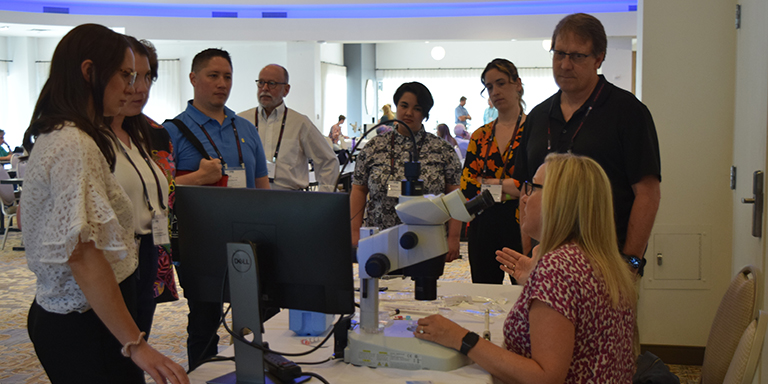
Newsletter
The College of Reproductive Biology (CRB) is a not-for-profit special interest group of the American Association of Bioanalysts (AAB).
How To Train Your Dragon: Best Practice For Raising A New Embryologist
Olga Chaplia, Ph.D., TS(ABB)
Although multiple institutions now offer programs that graduate embryologists, juniors are still being molded and refined for hands-on practice in their first IVF lab1,2. This process is time-consuming, challenging, and laborious for both sides - the trainee and the teacher, but crucial. Training serves to familiarize the new embryologist with standard procedures, guide them in mastering necessary skills, and nurture respectful and dependable relationships within the team. The noble yet demanding aim of raising a new generation of IVF professionals may become easier and less stressful when following these simple rules.
Standardization and clarity
Although there are many different ways to do things right in the lab (with regard to workload, equipment, and staff preferences or traditions), everyone, especially junior specialists, should follow the same standards. Start with introducing your new team member to the lab SOPs and explain why things are done in that exact way in your lab.
In the perfect world, the laboratory should also have a standard procedure for training newcomers, so that learning is carried out consistently across all trainees. This ensures effectiveness, gradual learning, and fairness for all juniors going through the process. A system of checklists for proper follow-up and review of their progress should also be in place2. Needless to say, apart from practical skills evaluation, the ethical and empathetic side of the trainee should also be assessed, as clinical embryology is not a job for irresponsible or insensitive people3. Even at preimplantation stages, babies should be raised in love.
The other side of standardized training is clear goals for the trainee. It is encouraging and inspiring to be able to track your own achievements and know exactly what is expected next. In this case, the newcomer sees a roadmap with the next stop on the way where mastering a new skill starts, rather than dreads being kept on the same level “forever”, collecting oocytes for years with no hope of progressing further.
Step-by-step approach and traceability
In order to build the full picture of laboratory work, introduce the basics first: demonstrate QC, daily setup, and routine maintenance. These steps, sometimes considered the most boring, are actually carrying the “fancy” results on their shoulders. Your blastocyst conversion rate is only as good as your everyday temperature measurement or gas tank handling.
The difficulty of tasks should evolve gradually: start with the simplest ones (easy to execute and supervise) and move step by step to the most demanding. Begin with dish preparation and end up with ICSI and biopsy, but don’t forget to introduce paperwork too. A junior mastering a new skill should also be capable of handling documents correctly and reading appropriate existing paperwork without confusion. Witnessing should also evolve gradually, so that the new team member clearly understands the idea of each procedure and provides proper support and double-checking of sample identity, rather than just putting the initials in the document under pressure or after a rushed explanation.
And of course, training should never affect patient cases. To provide a safe training environment (and to relieve the burden of responsibility from both trainee and clinic), the first steps should be done with discarded or animal material, with slow progression to partial case execution and, finally, to completing a patient case under supervision4.
Mentorship culture
Teaching a new team member is not always enjoyable, especially when the burden of training comes on top of daily routine tasks and is not appreciated. Training takes a lot of time, effort, and self-dedication from the teacher, and no wonder it is not always welcomed. On the other side, junior embryologists often feel excluded or ignored, because in a busy lab, their teachers simply don’t have enough time to provide proper training sessions.
But there are ways to make this demanding activity more enjoyable and more useful for both sides. Remember your own initiation into the profession, when you started with very little knowledge but a lot of eagerness. Your teachers were the most supportive people in the lab, and on the basis of their knowledge, you’ve built your own skills and experience. Now you can provide that same background for the next generation of talent.
Of course, the learning curve is different for everyone, but each trainee needs a chance to practice in order to master any skill. It is tempting to do everything yourself - it is faster, easier, and gets you home earlier - but training your “padawan” is a huge positive investment. Soon enough, they will be able to share the workload and make the lab’s daily life easier. So be patient and keep going. Remember: we are not raising a rival, we are raising an ally.
With all that said, a well-structured training program built on standardization, gradual learning, and mentorship not only shapes competent embryologists but also strengthens the entire laboratory team.
References
- ESHRE Working Group on Embryologist Training Analysis; Scarica C, Woodward BJ, De Santis L, Kovacic B. Training and competency assessment of Clinical Embryologists and licensing of the profession in European countries. Hum Reprod Open. 2023 Feb 11;2023(1):hoad001. doi:10.1093/hropen/hoad001. PMID: 36789007; PMCID: PMC9920573.
- Practice Committees of the American Society for Reproductive Medicine (ASRM) and the Society for Reproductive Biologists and Technologists (SRBT). Comprehensive guidance for human embryology, andrology, and endocrinology laboratories: management and operations: a committee opinion. Fertil Steril. 2022 Jun;117(6):1183-1202. doi:10.1016/j.fertnstert.2022.02.016. Epub 2022 Apr 27. PMID: 35487770.
- Basar M. Enhancing outcomes in IVF laboratories: navigating the human element through leadership and emotional intelligence. J Assist Reprod Genet. 2024 Oct;41(10):2557-2567. doi:10.1007/s10815-024-03239-x. Epub 2024 Sep 3. PMID: 39225839; PMCID: PMC11535114.
- Scott RT Jr, Hong KH, Werner MD, Forman EJ, Ruiz A, Cheng MC, Zhao T, Upham KM. Embryology training for Reproductive Endocrine fellows in the clinical human embryology laboratory. J Assist Reprod Genet. 2014 Apr;31(4):385-391. doi:10.1007/s10815-014-0189-0. Epub 2014 Feb 21. PMID: 24557835; PMCID: PMC3969461.
CRB News Articles
10/21/2025
Vol. 14, No. 2
10/21/2025
Welcome Letter by Alison Bartolucci, Ph.D., HCLD(ABB)
10/21/2025
CRB News Updates
10/21/2025
CMS Validation Inspections: A Real Possibility
10/21/2025
Latest Research On Fertilization Assessment
10/21/2025
Artificial Intelligence: The Question Is Not If We Should Use It, But How We Use It Responsibly
10/21/2025
How To Train Your Dragon: Best Practice For Raising A New Embryologist
10/21/2025
Andrology Antics by Samuel Prien, Ph.D., HCLD(ABB)
10/21/2025
Contribute to the CRB Newsletter!
CRB Standing Rules - Log in to view



